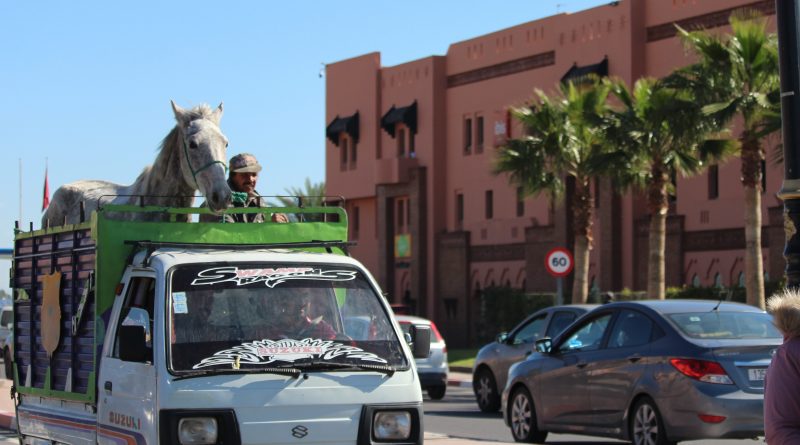
Tough Trucks of Morocco
Laura Guiauchain travels in a variety of trucks to the four Imperial Cities, seeking the origins of Morocco. Following the ancient trade routes, once the domain of Berber camel trains, but now used by some of the 250,000 HGVs which travel north each year through the port of Tangier. Laura meets truckers and historians to tell the Moroccan story and pinpoint important moments in its history. Along the way she will experience the Moroccan Hollywood, taste the Berber lifestyle, join the Tuareg Rally and drive the world’s first fully electric pick-up truck, the Aslan.
Starting in a campsite known as “Between Here and Marrakesh”, Le Relais, Laura encounters travellers Roland and Andrea, who have a fifty-year-old Austrian armoured car which they are about to drive for six hours across the Atlas Mountains, to the Sahara. They drop her near the Medina, where Laura gets a henna tattoo. Marrakesh was built on “Love and Water”, by the Almoravids. At the Islamic Library, historian and Islamic Scholar, Jafaar Kansoussi, reveals an Almohad Koran as a beautiful and important work with ancient calligraphy, which pre-dates the Koutoubian Mosque which dominates the City. Mr Kansoussi reveals that the city was built over the Sultan’s love for his Queen.
Being ingenious engineers, the Almoravids irrigated their orchards with water from the Atlas Mountains. At the Menara Pavilion Laura has a moment to ponder its beauty, before finding Nabil, her first trucker. Nabil drives the biggest Tough Truck Laura has ever seen, operated by a family firm called Transmel. They set off from Marrakesh for the Atlas Mountains and begin a hazardous journey over the Tichka pass, which becomes difficult to navigate but as Nabil says, “passable”. Late at night they arrive at the centre of the Moroccan Film industry, Ouarzazate.
The Atlas Studio has hosted numerous superstars of the screen, and mega-movies. These include Ridley Scott’s “Kingdom of Heaven” Martin Scorsese’s “Jesus of Nazareth” and Laura’s favourite, “Jewel of the Nile”. It is the largest studio in the world, and the go-to location for many movies set in the Middle East. After roaming the ramparts and scenery, Laura goes in a water truck 180 kilometres north to the Valley of 1000 Ramparts, where the Berbers built stunning red mud castles along a winding route through the Dades Gorge. It is a highly fertile and rugged terrain, and the centre of rose growing and perfume production.
Laura arrives in the Sahara, and meets the local traders in camel’s milk and Tuareg clothing. The peace is broken by the sound of roaring engines as the UK’s bowler team from Derbyshire race their flatbed pickup trucks in the Tuareg Rally. Team principal Andrew Chester explains the challenges of desert and the thrills are ably demonstrated when driver Andrew Wicklow takes Laura for a spin on the dunes.
Being a culture vulture, Laura jumps on a Man Truck heading north, where she joins archaeologists restoring the ancient site of Volubilis. Dr Omar Bouka explains the slow process of restoring the tiles in a dining room occupied by Roman settlers, who built a city after the marriage of Caligula’s daughter to Berber King Juba 2nd.
In 782 the most momentous change in Morocco occurred when Moulay Idris, on the run from Iraq, established a colony near Volubilis. This began the first Islamic dynasty in Morocco, and the citizens of the “wonder of the world” city built on a mountain, show Laura Berber hospitality, and she returns the favour by enticing tourists to try out the incredible local tagine, which hails from the same period.
Moving on to Fez, the largest Souk in the world draws Laura in to its centre and the Copper and Tanning districts. The world authority on the Imperial Cities, Professor Mohamed Metalsi, shows Laura the rooftops of the City and its importance in understanding Morocco. The most notorious Sultan, Moulay Ismail built another glorious capital in Meknes. He kept a private army of African and European slaves called the Black Army. He is reported to have had eight wives and numerous concubines in his harem, where he sired scores of children. His summer palace rivalled Versailles. The stables in Meknes held 12,000 of his horses which each had a slave and a groom.
Finishing her journey in Rabat, Laura charts the modern history of the royal dynasties, visiting the tombs of Mohammed the Vth who modernised Morocco after partition and occupation by the French, and then saw a turbulent reign of Hassan 2nd who ruled as an absolute monarch. Taking the air of the Oudayah Ramparts which appear to have grown out of the sea, Laura ruminates that under the current monarch, Mohammed V1th, the story of the Moroccan dynasties and its imperial Cities, has only just begun.
Credits
*
presenter
LAURA GUIAUCHAIN
*
with special thanks to
MEDLOC MAROC
TRANSMEL
MOROCCAN NATIONAL TOURIST OFFICE
MUSTAPHA ATKI – VOLUBILIS
ADIL MDASNI – MDS TRANS
MAN TRUCK & BUS AG
BOWLER MANUFACTURING LTD.
DIRECTION DU PATRIMOINE CULTUREL
DEPARTEMENT DE LA CULTURE
OPEN MOTORS
*
fixer
SOUHEIL HALLAOUI
BADR YAHMANI
*
titles & graphics
MARTINA DEO
camera assistant
EMILIO REY
*
facilities
GUILTFREE POST
dubbing mixer
JOHN PURCELL
*
online editor
DANNY DAVIS
editor
ALEKSANDAR NIKOLIC
*
music by
MICHAEL CONN
MALCOLM LAWS
NAINITA DESAI
AMANDA KRAMER
MARTYN SWAIN
PAUL MOUNSEY
IAN RITCHIE
JON WYGENS
COLIN WINSTON FLETCHER
SITTING DUCK
*
post production coordinator
EMILIO REY
JAKE CHRISTIAN
production accountant
RASHIDA PATEL
*
production manager
MARIA VENTURA
*
executive producer
IAN CROSS
*
Filmed, produced and directed by
MATTHEW LYNCH
*
Produced by Pilot Film and TV Productions for Travel Channel International
© Pilot Productions MMXVIII
